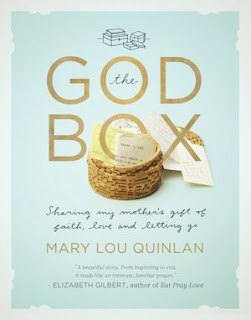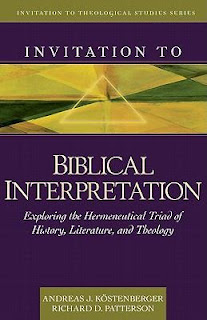TITLE:
Invitation to Biblical Interpretation: Exploring the Hermeneutical Triad of History, Literature, and Theology (Invitation to Theological Studies Series)
AUTHOR: Andreas J. Kostenberger and Richard D. Patterson
PUBLISHER: Grand Rapids, MI: Kregel Publications, 2011, (896 pages).
This book is a gift to the theological community, seminaries, libraries, churches, and organizations that want to grow in learning to interpret the Bible better. With nearly 900 pages, this book packs in a lot of material. Primarily written for teachers and students, there is a lot for pastors, missionaries, teachers at various Christian organizations to benefit from. The key thesis of this book is the Hermeneutical Triad (HT) in which every interpretation needs to be done through a journey which incorporates three components: the historical contexts, the literary genres, and the theological implications. While the concept is not exactly new, the term HT is.
A) History
The authors dive in deep and wide. Not only do they mine the deep recesses of each biblical genre, they pull in the breadth of history in the Old Testament times (Primeval, Patriarchal, Monarchy, Divided Kingdom, Exilic, Persian, Maccabean, etc), the Early Church in New Testament era (Graeco-Roman, Jewish, etc), the Apostolic and Church fathers, the Alexandrian and Antioch schools of learning, Jerome, Augustine, the Monastic and the Medieval schools, the Reformation, the Enlightenment as well as Modernism. The authors recognize the lack of appreciation of history by people in this modern era, and are able to keep the reader on track through well demarcated section headings, illustrations, tables, and stories of the important characters in history.
They not only teach, they show the way to apply the teaching through sample exegeses, and guidelines. The study questions, assignments and bibliography will whet the most ardent students' appetite.
B) Literature
In this section, the authors brilliantly releases their deep passion for teaching hermeneutics and literary appreciation. They provide a deep level of details into how one ought to read the Law, the Prophets, the Writings. What kinds of laws are they and how are they to be read and applied? What are the guidelines to understand the Exodus and the Exile? Who is the Messiah? What are the important Old Testament themes?
In the New Testament, the authors guide readers through the gospels, Acts, the letters and the Apocalypse. From canon, the authors move to genre in which they link together the individual books so that it appears more and more like one story out of many. Even as they link the big picture to show how Revelation is connected to the entire Old Testament, they do not compromise on the importance of syntax, the linguistics, the semantics, and the figurative language so common in the Bible.
C) Theology
After the heavy lifting of history and literature, the authors come to the 'third and crowning aspect' of the HT: Theology. In fact, it is the author's belief that a good grasp of the historical and the literary, equips the reader to understand the theological underpinnings of the interpretive process. For them, theology is not just 'biblical theology' which is mainly from the perspectives of the biblical writers. They are mindful that every school of biblical theology is an interpretive presupposition in themselves. Whether, tradition, personal preferences, experience or prejudice, different people interpret differently. The author suggests: 'patient, repeated study' as a way to close this gap. After going through a history of biblical theology, they provide 6 guidelines for biblical theology, 7 guidelines on how the New Testmanet interprets the Old Testament, and another 7 questions to let students ponder on the meaning behind biblical theology. This is the way in which the authors seek to enable the learners toward 'patient, repeated study.'
In other words, good biblical theology is not about learning something right one time. It is about learning something right, and to keep learning something deeply right.
D) Closing Thoughts
I like this book for its graciousness to the other previous two models highlighted, and its very clear manner in which it describes the triad of biblical interpretation. The authors are able to highlight the strengths of each 'geometric figure' without diluting their own model. In fact, they are spot on in saying that this proposed 'hermeneutical triad' framework does not mean it is necessarily 'superior' to the hermeneutical circle or spiral. It complements. Having said that, the authors are convinced that their hermeneutical triad of history, literature, and theology bears the following uniqueness:
- In contrast to the Hermeneutical Spiral (HS), the hermeneutical triad (HT) moves from the specific to the general, which allows a more succinct application purposes;
- Instead of beginning with word studies, HT begin with context;
- Instead of beginning with genre-based interpretations, HT utilizes genre+canon; from syntax first to biblical discourse first; from semantics to meaning.
- In history, HT enables the appreciation of how God reveals himself in history
- In literature, HT looks at the Bible literary from three angles: canon, genre, and language.
- In theology, HT summarizes the historical and the literary into a theological understanding.
- HT blends in interpretive task with methodical systems.
The system is designed for teachers and students to be trained in the Hermeneutical Triad. Using the journey metaphor, the authors guide the reader each step of the way, presenting a plan at the beginning of each chapter, filling in the blanks as one travels along, making observations and conclusions, and throughout the process, inviting the student and reader to maintain a stance of interpretation that keeps together history, literature, and theology as one whole. What I appreciate is that the authors take pains to ensure that interpretative and application comes hand in hand. It is not to be an afterthought but to be a constant thought. It is not to be relegated toward the end, but considered throughout the interpretive process. Even though there is a last chapter that is specifically called 'Application and Proclamation,' I suspect it is there simply because the general reader intuitively expects it to be there, much like one expects to pay for food after ordering the items. This final part deals with study preparations, sermon outlines, and the specific ways in which the various kinds of Bible books can be preached. The wealth of resources, Bible helps, both electronic and printed materials, are given toward the end of the book to enable the interested student to benefit from. The sermon tips are especially helpful because preaching is indeed one of the most powerful applications of any interpretive task. The guidelines for applications are especially helpful. Moreover, the book enables the systematic learning in parts as student, so that at the end of the journey, one will naturally be able to synthesize it back together again. This in itself is a valuable reason to read/buy this book!
My verdict: The serious student needs to read this book. Preachers will benefit from reading this book and learning its sermon outlines. Teachers will find this book a very good introductory textbook to use in their hermeneutics classes. Pastors will appreciate the many strands of historical, literary, and theological frameworks this book offers. The layperson will find that this book is very readable as it explains technical theological terms in simple language.
I am full of praise for this edition, and I believe that there will be many more editions and additions of material to come in the years ahead. The Hermeneutical Triad is the new landmark in the field of hermeneutics. If I am teaching hermeneutics, this book will definitely be my main textbook.
Ratings: 5 stars of 5.
conrade
This book is provided to me free by Kregel Academic without any obligation for a positive review. All opinions offered belong to me unless otherwise stated.



















